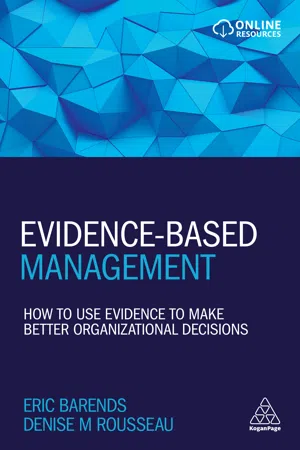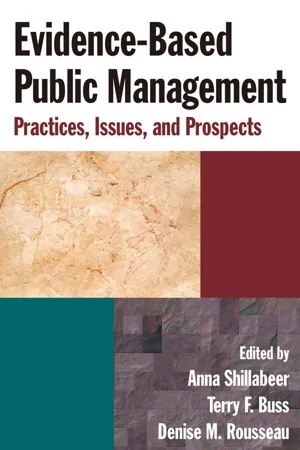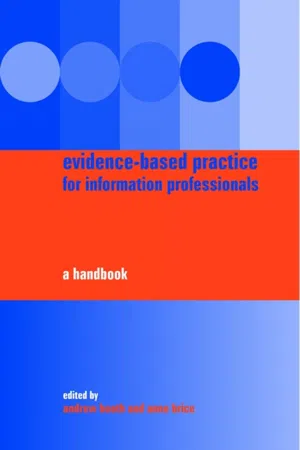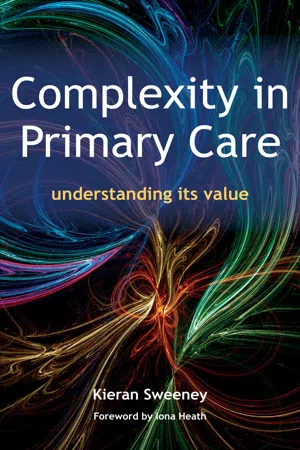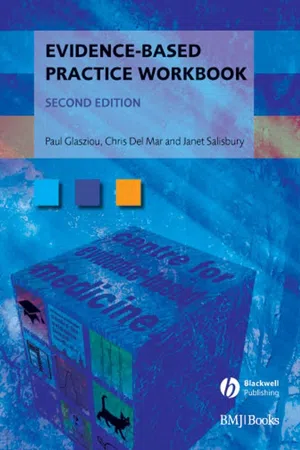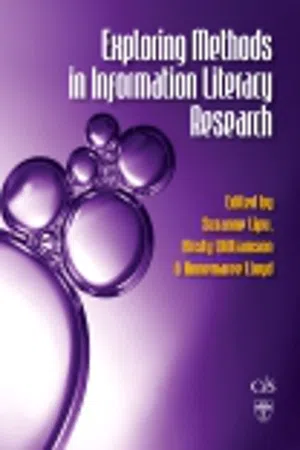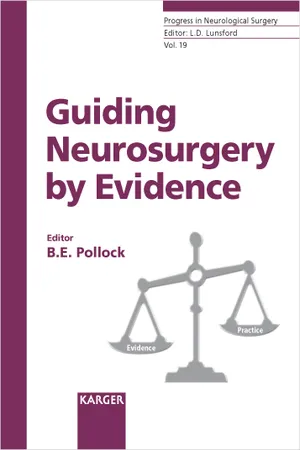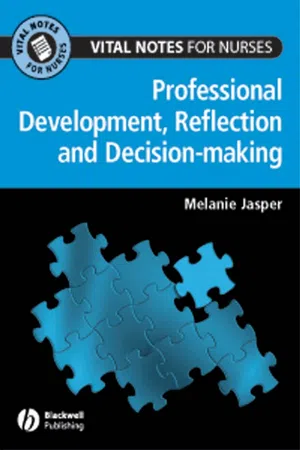Business
Evidence Based Management
Evidence Based Management involves making decisions and taking actions based on the best available evidence from research, data, and experience. It emphasizes the use of empirical evidence to inform business practices and strategies, aiming to improve organizational performance and outcomes. By integrating evidence into decision-making processes, organizations can enhance their effectiveness and achieve better results.
Written by Perlego with AI-assistance
Related key terms
1 of 5
12 Key excerpts on "Evidence Based Management"
- eBook - ePub
Evidence-Based Management
How to Use Evidence to Make Better Organizational Decisions
- Eric Barends, Denise M. Rousseau(Authors)
- 2018(Publication Date)
- Kogan Page(Publisher)
Whether we work in a bank, hospital, large consulting firm or small startup, as practitioners affecting the lives of so many, we have a moral obligation to use the best available evidence when making a decision. We can do this by learning how to distinguish science from folklore, data from assertions, and evidence from beliefs, anecdotes or personal opinions. 1.1 What is evidence-based management? The basic idea of evidence-based management is that good-quality decisions require both critical thinking and use of the best available evidence. Of course, all practitioners use some kind of evidence in their decisions. But few pay attention to the quality of the evidence. The result is decisions that rely on unfounded beliefs, fads and fashions, and the unsupported though popular ideas of management gurus. The bottom line is bad decisions, poor outcomes and little understanding of why things go wrong. Evidence-based management seeks to improve the way decisions are made. It is an approach to decision-making and day-to-day work practice that helps practitioners to critically evaluate the extent to which they can trust the evidence they have at hand - eBook - PDF
Management Studies in Crisis
Fraud, Deception and Meaningless Research
- Dennis Tourish(Author)
- 2019(Publication Date)
- Cambridge University Press(Publisher)
Is there is a third way which can preserve EBM’s welcome focus on addressing real world problems without having to adhere so closely to the managerialist agenda that accompanies it at present? 189 The writing on EBM draws repeatedly on the precedent of ‘evi- dence-based medicine’. We have had an explosive growth of interest in the management version of this approach. Beyond the journal literature, several books from key figures have also been produced, aimed at both management and academic audiences. Their overall intention is to have a transformative impact on management practice. The importance of impact on ‘the real world’ is heightened, and one supposes that theory development is in principle subordinate to the need to inform manage- ment practice. This is certainly the thrust of the definition offered by Eric Barends, Denise Rousseau and Rob Briner, as follows: Evidence-based practice is about making decisions through the conscientious, explicit and judicious use of the best available evidence from multiple sources by 1. Asking: translating a practical issue or problem into an answerable question 2. Acquiring: systematically searching for and retrieving the evidence 3. Appraising: critically judging the trustworthiness and relevance of the evidence 4. Aggregating: weighing and pulling together the evidence 5. Applying: incorporating the evidence into the decision-making process 6. Assessing: evaluating the outcome of the decision taken to increase the likelihood of a favorable outcome (emphasis in the original). 3 But nothing is ever that straightforward. Critics of EBM have chal- lenged its alleged privileging of a management voice above that of other organisational actors, and questioned its belief that we have enough good evidence from which supposedly best practices can be identified. - eBook - ePub
Evidence-Based Public Management
Practices, Issues and Prospects
- Anna Shillabeer, Terry F. Buss, Denise M. Rousseau(Authors)
- 2015(Publication Date)
- Routledge(Publisher)
Chapter 8 attempts to sort out these conundrums.This leaves evidence-based management (EBMgt). Evidence in management, whether in the public or private sector, concerns the need to support management decision making with sound research. The impetus for EBMgt comes from the fact that much of what constitutes good management practice is likely based on faddism —personal memoirs, limited case studies, rank speculation, and many textbooks and the like that purport to be the latest in good management (Watson 2009; Moss and Francis 2007; Pfeffer and Sutton 2006; Brindle and Stearns 2001). Unfortunately, when examining these resources, one soon finds they have no scientific basis in fact, most are contradictory when examined side by side, a lot have led to organizational failure, and over time advice for managers dramatically changes as one fad replaces another.So, the field is cluttered with terms of art that really do not represent a body of knowledge where there is much consensus. The field has no common view about what management is, what good management is, what evidence is, what good evidence is, what methods ought to be used, and perhaps what it all means. Every chapter in this volume touches on these issues in one way or another. This makes EBMgt a very interesting enterprise in which to work! We believe the work is well worth doing.Origins
A third point of contention and confusion concerns whether evidence-based approaches, especially in management, are new, emerging, or long established. Most of the commentary on evidence-based approaches suggests that use of evidence in medical research and practice is the antecedent of and the inspiration for the approach. For our purposes, modern evidence-based medicine (EBM) emerged as a field in the 1970s with the work of Archie Cochrane (1992). Cochrane advocated for and convinced the medical research community they needed to demonstrate through experimental research that their practices and treatments were efficacious: patients have a way of getting well regardless of the treatment or lack thereof. Cochrane, who passed away in 1988, was honored when his colleagues launched the Cochrane Collaboration in 1993 with this rationale: “Evidence-based medicine is the conscientious, explicit and judicious use of current best evidence in making decisions about the care of individual patients. The practice of evidence-based medicine means integrating individual clinical expertise with the best available external clinical evidence from systematic research” (http://www.cochrane.org/docs/ebm.htm). - eBook - PDF
Organizing and Reorganizing
Power and Change in Health Care Organizations
- L. McKee, E. Ferlie, P. Hyde, L. McKee, E. Ferlie, P. Hyde(Authors)
- 2008(Publication Date)
- Palgrave Macmillan(Publisher)
6 Evidence-Based Management: The Power of Evidence or Evidence of Power? Mark Learmonth Introduction Evidence-based health care (EBHC) has now enjoyed over 10 years of popularity in many clinical fields across the globe. Today, it seems axiomatic that all health care practice can, and should, be evidence-based – that is to say, practice should integrate individual clinical expertise ‘with the best available external clinical evidence from systematic research’ (Sackett et al. 1996:71). But whilst EBHC can ‘work’ – at least when work means (quite specifically) that aggregate clinical outcomes are improved – its overall successes are overdrawn (evidence-based medicine rarely provides categorical, recipe-style answers for individual clinical situations). Indeed, much optimistic hype is accumulating about EBHC with some unintended consequences. For example, the question of whether or not clinical practice can be said to be evidence-based is taking on a significance that is wider than its mere effectiveness. As Morse suggests, today, ‘[e]vidence and evidence-based practice have become the new mantras for health care’ (2006:80; italics in original). To be able to claim practice is ‘evidence-based’ provides a significant source of prestige and legitimacy that contributes to the construction of professional identity (Green 2000; Traynor 2004). Furthermore, the same ideas that underpin evidence-based medicine have become central, not merely in guiding individual clinicians’ practice, but also in shaping research agendas, formulating health policy and allocating resources (Lambert et al. 2006). Evidence-based practices are taking on a legitimatory and symbolic role which create a cultural environment in health care in which any problematization of using ‘evidence’ – virtually regardless 75 76 Evidence-Based Management of context – can be constructed (and dismissed) as reminiscent of early arguments against evidence-based medicine. - eBook - PDF
- Andrew Booth, Anne Brice, Andrew Booth, Anne Brice(Authors)
- 2004(Publication Date)
- Facet Publishing(Publisher)
Difficulties in specify-ing and conducting quality assessments of studies constitute a major challenge BOOTH TOWARDS EVIDENCE-BASED MANAGEMENT 205 in developing a systematic review methodology for management research (Tranfield et al., 2002). Acting on the evidence Evidence-based practice recognizes that managers should use personal experi-ence and problem-solving skills rather than relying solely on the results of systematic reviews (Rosenberg and Donald, 1995; Bero and Rennie, 1995). Values, resources and judgement all contribute to the interpretation and appli-cation of research findings (Macdonald, 1999). In fact the UK Government Cabinet Office goes further, describing evidence as: ‘Expert knowledge; published research; existing statistics; stakeholder consultations; previous policy evaluations; the Internet; outcomes from consultations; costings of policy options; output from economic and statistical modelling’ (Strategic Policy Making Team, 1999). Evidence-based management has a major contribution to make in acknowl-edging that evidence alone is often insufficient and incomplete, only informing decision making by reducing uncertainty (Nowotny et al., 2001). Increasingly, sys-tematic reviews of management research aim to improve the precision of a reliable evidence base and effect more sensitive judgements by policy makers and practitioners. Nevertheless the gap between having the evidence and imple-menting it continues to elude managers (Farmer, 2001). Evidence suggests that when managers make decisions they are more likely to be influenced by relationships and historical patterns of service provision (Laing and Cotton, 1996). Even where recourse is made to the literature, man-agers, more than any other sector, debate whether lessons from one organization are transferable and applicable to another within the same sector, let alone in other sectors. - eBook - ePub
Complexity in Primary Care
Understanding its Value
- Keiran Sweeney(Author)
- 2017(Publication Date)
- CRC Press(Publisher)
There are certain important epistemological implications for that model, namely that it is predicated on rational positivism, with an ontological conception of disease as real and distinct entities awaiting discovery and classification. In this chapter, I shall dig deeper into the explanatory model by describing and critiquing its contemporary manifestation in the form of evidence-based medicine (EBM). The purpose here is to develop the argument that is unfolding in this book, from a justification of the proposition that science dominates the model to an exploration of the implications of that model for everyday general practice. The aim is to arrive at a position in the argument where it can appropriately be held that, although science is a necessary (and indeed vital) component of the explanatory model, it is insufficient in itself to constitute that model.Let us recall what is meant by the term ‘evidence-based medicine.’ The method is described as having five steps (Evidence-Based Medicine Working Group, 1992; Oxman et al ., 1993; Davidoff et al ., 1995; Rosenberg and Donald, 1995; Dawes, 1996; Sackett et al ., 1996).- A clear clinical question is formulated from the patient’s presenting problem.
- A literature search is conducted in order to identify relevant published articles that consider the problem.
- The evidence is accessed and evaluated (or critically appraised).
- Valid and useful indings are implemented in clinical practice.
- An audit of performance is conducted.
The ‘evidence’ in EBM refers to a hierarchy in which the indings of fully randomised controlled trials are at the top, followed by less well-controlled trials, cohort studies, expert consensus views and authoritative opinion.This chapter explores EBM in four stages. First, the principles of EBM are explained and placed in context (Dawes, 1996). Next, I reflect on a description of the method (Rosenberg and Donald, 1995) and an early example of its application in an acute medical unit of a teaching hospital (Ellis et al - eBook - ePub
Managing Long-term Conditions and Chronic Illness in Primary Care
A Guide to Good Practice
- Judith Carrier(Author)
- 2022(Publication Date)
- Routledge(Publisher)
Glasziou 2011 ). The term first appeared in print as follows:A NEW paradigm for medical practice is emerging. Evidence-based medicine de-emphasizes intuition, unsystematic clinical experience, and pathophysiologic rationale as sufficient grounds for clinical decision making and stresses the examination of evidence from clinical research.(Evidence-Based Medicine Working Group 1992 , p.2420, emphasis in original)Despite the relatively short history of EBM, Glasziou (2011 ) has previously observed that the ideas underpinning it evolved over centuries, with roots in psychology, sociology and philosophy. Additionally, a large part of the vocabulary used to describe EBP was invented and developed by statisticians and epidemiologists. EBM expanded rapidly post the 1990s to include all aspects of healthcare. Within the UK centres for EBP developed rapidly supported by modern disciples such as David Sackett and colleagues. Sackett et al.’s British Medical Journal (BMJ) (1996) historical editorial ‘Evidence-based medicine: what it is and what it isn’t’ is fundamental reading for those interested in EBP. Sackett et al. (1996 , p.71) classic definition of EBM states that:Evidence based medicine is the conscientious, explicit, and judicious use of current best evidence in making decisions about the care of individual patients. The practice of evidence-based medicine means integrating individual clinical expertise with the best available external clinical evidence from systematic research.Following this EBHC continued to move on with increasing speed and vigour. The aim of EBHC today is to ensure that all health care practice is firmly grounded in a sound evidence base that considers individual patient need and preferences. - eBook - PDF
Evidence-Based Practice Workbook
Bridging the Gap Between Health Care Research and Practice
- Paul P. Glasziou, Chris Del Mar, Janet Salisbury(Authors)
- 2009(Publication Date)
- BMJ Books(Publisher)
It is not scientific evidence for a mechanism of action (such as a biochemical pathway, physiological effect or anatomical feature). Many factors affect the outcomes of clinical activities; the underlying mechanism is only one of them. Evidence-based practice (EBP) is concerned with actual clinical outcomes and is the term that we will use in this workbook. “ … the integration of best research evidence with clinical expertise and patient values ” – Dave Sackett Some essential elements of the EBP approach 1. Recognise uncertainties in clinical knowledge 2. Use research information to reduce uncertainties 3. Discriminate between strong and weak evidence 4. Quantify and communicate uncertainties with probabilities Reference: Sackett DL, Strauss SE, Richardson WS, Rosengerg W, Haynes RB (2000). Evidence-based Medicine: How to Practice and Teach EBM , Churchill Livingstone, Edinburgh. Photograph reproduced with permission. 4 Why do we need EBP? Unfortunately, there is a large though variable gap between what we know from research and what we do in clinical practice. Because so much research is published — some valid and some invalid — clinicians understandably are unaware of most of it, or do not have the ‘tools’ to assess its quality. Researchers, on the other hand, may not understand the information needs of clinicians and often present their work in a way that is not easily accessible to busy practitioners. In 1972, British epidemiologist Archie Cochrane highlighted the fact that most treatment-related decisions were not based on a systematic review of clinical research. Rather, they were based on an ad hoc selection of information from the vast and variable quality scientific literature, on expert opinion or, worst of all, on trial and error. Cochrane proposed that researchers and practitioners should collaborate internationally to systematically review all the best clinical trials (that is, randomised controlled trials, or RCTs), specialty by specialty. - Suzanne Lipu, Kirsty Williamson, Annemaree Lloyd(Authors)
- 2007(Publication Date)
- Chandos Publishing(Publisher)
Cochrane's premises were that because resources would always be limited they should be used only where they have been shown to be effective (Cochrane 1972). It is important not to take diminishing resources as a given. The Iraq war has consumed disproportional resources, while health, welfare and education have received ongoing reductions. 1 The core concepts of EBM are based in work done in the 1970s and 1980s addressing Cochrane's accusation that many of the treatments, tests and procedures used in medicine had no evidence to demonstrate their effectiveness, and may in fact be doing more harm than good (Hill 2000, p.l 190). A definition of EBM often cited is: Evidence-based medicine is the conscientious, explicit, and judicious use of current best evidence in making decisions about the care of individual patients. The practice of evidence-based medicine means integrating individual clinical expertise with the best available external clinical evidence from systematic research (Sackett et al. 2007, p.71). 1 The striking feature of modern war is its expense. The cost of the war in Iraq is estimated at $US 2.3 trillion (Stephen 2007). 'The cost of the Iraq war to Australian taxpayers is approaching $3 billion and is rising at a faster pace as the conflict has reached its fourth anniversary' (Davis & Coorey 2007). The evidence-based model of information literacy research 173 From another angle, Hollway (2001) questions the reductive definition of what counts as evidence. Particularly from the 'caring' professions perspective, Hollway wonders whether scientific evidence epitomised in EB practice compromises the helping professions by threatening 'to impose reductive and standardised interventions' (Hollway 2001, p. 10). EBM concepts were taken up by library and information professionals interested in information literacy (IL).- eBook - PDF
Evidence-Based Clinical Practice in Nursing and Health Care
Assimilating Research, Experience and Expertise
- Alan Pearson, John Field, Zoe Jordan(Authors)
- 2009(Publication Date)
- Wiley-Blackwell(Publisher)
Much has also been said of the need to involve professional groups in the development of an evidence-based practice culture within an organisation. This is a prerequisite for success in such an endeavour. Kenrick and Luker (1996) further develop the theme of the place of manage- ment in research utilisation, but do so in the context of a district nursing service. Their focus is on the utilisation of research by district nurses who deliver their services in a professionally insular setting, usually isolated from any form of peer review. Their perspective is that of a manager of a district nursing service faced with the ever-increasing imperative to deliver high-quality, effective and efficient services. The authors investigated the link between management culture and clinical practice in an attempt to gain insights that would assist in this task. Apart from providing an interesting profile of a group of nurse managers, Kenrick and Luker conclude that effective, evidence-based practice depends on having a positive organisational culture. An interesting point about this study is the extent to which their own practice is evidence-based. There is an ambiguous allusion to this when they discuss the managers’ practices and the extent to which their own practices are evidence-based. It is not altogether clear whether they are referring to the managers’ clinical practices or managerial practices. However, if the managerial practices are evidence-based, the question remains as to the quality of the evidence. Health professions do not have a monopoly on either evidence-based practice or poor-quality research. Evidence-Based Practice: Issues and Challenges 157 In practice . . . Your friend the teacher will no doubt have a strong interest in the foregoing mate- rial. How do you see the principles of evidence-based practice translating into a pro- fession such as teaching, or put another way, a discipline such as education? - eBook - PDF
- B. E. Pollock, Konstantin V. Slavin(Authors)
- 2006(Publication Date)
- S. Karger(Publisher)
However, as a closed, reductive, and deductive system, it tends to be relatively sterile for generating innovation, and for identifying potential strate-gies for filling these gaps. It is the soundest basis for developing and establish-ing clinical practice parameters. With the support and backing of governmental agencies, professional med-ical societies, the AAMC, the ACGME, and the ABMS, EBM is likely here to stay. While some have argued that RCTs, meta-analysis, and guidelines have peaked in popularity, and are already on the decline [117], this is probably not correct. One can liken any perceived lull in penetration and impact to the time necessary for consolidation of an established beachhead, just prior to the defin-itive breakout and complete penetration across the countryside. The fact that (1) EBM philosophy and critical appraisal techniques have become fully integrated into the training and culture of our younger colleagues (who will comprise an ever-increasing percentage of neurosurgical practition-ers), (2) the fact that maintenance of certification will require individuals to demonstrate personal evidence-based practice based on tracking and critical analysis of personal practice outcomes as part of the performance-based learning and improvement competency, and (3) the fact that the progressively growing national healthcare expenditures (now approaching 20% of our gross national product) will necessitate increasing basis of reimbursement and funding based on evidence-based effectiveness and guidelines, all point to the likelihood that complete immersion of neurosurgical practice in EBM is inevitable. Widespread small-area variation in clinical practice and perceived high levels of avoidable error will also likely drive this effort. The EBM movement has convinced busi-nessmen, politicians, bureaucrats and consumers that probabilistic knowledge of medical effectiveness is the means to better healthcare [196]. - Melanie Jasper(Author)
- 2011(Publication Date)
- Wiley-Blackwell(Publisher)
When nurses make evidence-based decisions in these clinical situa-tions, they would do well to pay attention to the findings of RCTs, and to make decisions based on exclusive hierarchies of evidence which evaluate research findings in terms of the validity and reliability of the methods used to generate them. On the other hand, however, many nursing interventions would also benefit from regarding nursing as a ‘science of the unique’ (Rolfe and Gardner 2005 p. 297) which is: ‘based on the premise that nursing is a series of individual and unique encounters which cannot be described by a science of large numbers.’ In these cases, findings from generalisable research cannot be counted upon to provide nurses with reliable information on which to make judgements about the unique clinical situations they find them-selves in. What is required here is a more intimate, personal and intu-itive form of decision-making based on the expertise of the nurse and their personal knowledge about the individual patient. Chapter summary The first paper outlining the principles of evidence-based medicine was published in 1992, and after only three, Davidoff et al. (1995) were asking ‘why all the fuss?’ and arguing that EBM was so obviously the route to best practice that they could not see how anyone could object to it. However, early attempts to apply the principles of EBM to nursing met with some strong objections by those who saw the role of the nurse as very different to that of the doctor, and we have spent the past decade attempting to clarify exactly how nurses might work within an evidence-based framework. Whilst some nurses have concluded that the most promising route is to follow the lead of our medical col-leagues, others have argued for a far broader approach which encom-passes not only evidence from qualitative research, but also reflective practice and expertise.
Index pages curate the most relevant extracts from our library of academic textbooks. They’ve been created using an in-house natural language model (NLM), each adding context and meaning to key research topics.
